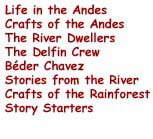|
"The River Dwellers"
Text by Béder Chávez
 The
people who live in the Peruvian Amazon river basin are called Rivereños
which means "river dwellers." These people are generally either "mestizos"
(of mixed European and indigenous heritage) or of the many different
ethnic groups living in the area. Some of these ethnic groups are the
Cocamas, the Ticunas, the Yaguas, the Witotos, the Boras, the Ocainas,
and the Yameos. The largest ethnic groups are the Cocamas and the Yaguas. The
people who live in the Peruvian Amazon river basin are called Rivereños
which means "river dwellers." These people are generally either "mestizos"
(of mixed European and indigenous heritage) or of the many different
ethnic groups living in the area. Some of these ethnic groups are the
Cocamas, the Ticunas, the Yaguas, the Witotos, the Boras, the Ocainas,
and the Yameos. The largest ethnic groups are the Cocamas and the Yaguas.
While there are many native languages here, many of the Rivereños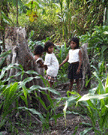 speak only Spanish. The great majority of the people here are Christians.
The Rivereños are very peaceful and friendly people and have
a tradition of hospitality.
speak only Spanish. The great majority of the people here are Christians.
The Rivereños are very peaceful and friendly people and have
a tradition of hospitality.
Rivereños are able to live in the forest because they fish,
farm, and hunt for their food. Their diet consists mainly of fish, manioc,
rice, beans, papaya, and pineapple. They grow maize, yuca, mangoes,
and beans in small plots of land scattered throughout the villages.
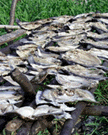
There are over a thousand types of fish in the rivers, many of which
are caught by the fishermen to eat. Often the fish is dried on racks
to preserve it. Rivereños trade for other items they need among
themselves or with others in the area. Some people travel to Iquitos
with goods to sell in the markets.
One of the typical dishes of the Rivereños is the juane which
is made of rice and chicken. The rice and the chicken are boiled separately
with seasonings and then wrapped in banana leaves. Sometimes they add
hard boiled eggs and olives.
|
 The
most typical drink in the area is called masato. It is made from
the yuca or tapioca root. The women boil
the tubers and then mash them with a large pestle. The women then
chew the paste to mix it with saliva. The saliva helps with the
fermentation process. They spit the softened paste into a trove
where it ferments for a day or so. The
most typical drink in the area is called masato. It is made from
the yuca or tapioca root. The women boil
the tubers and then mash them with a large pestle. The women then
chew the paste to mix it with saliva. The saliva helps with the
fermentation process. They spit the softened paste into a trove
where it ferments for a day or so.
Rivereños live in thatch-covered huts that are made using
the natural resources found in the forest. Palm wood is used for
the floors and the palm fronds are used for the roofs. Generally
houses have a larger central room in front with a couple of smaller rooms
in the back for more privacy. There is a room for cooking and
eating. The "stoves" are wood fire pits in the floor and filled
with clay. The smoke that rises from the fire coats the thatch
above with a residue that helps keep out the rain. Every four
years or so they must replace the thatch roofs.
have a larger central room in front with a couple of smaller rooms
in the back for more privacy. There is a room for cooking and
eating. The "stoves" are wood fire pits in the floor and filled
with clay. The smoke that rises from the fire coats the thatch
above with a residue that helps keep out the rain. Every four
years or so they must replace the thatch roofs.
All the houses are built on stilts a few feet above the forest
floor. The river rises during the course of the year by as much
as 36 feet. Where there was forest floor in the dry season, during
the wet season the people find themselves living surrounded by
water. Sometimes they even have to raise their floors higher because
the river is so high. Going to a neighbor's house requires a canoe.
 Many
villages have a school house and at least one teacher. Primary
education is free so that all children can go to school. In the
jungle there are no school buses. Children either walk to school
or travel by canoe when the water is high. In school they study
science, math, Spanish, social studies, and art. Everywhere you
look in the village there are children with their beautiful smiles.
Like children everywhere in the world, they are also busy playing
games. They are always curious about the people who come to visit
them. Most children are barefooted and only wear shoes when Many
villages have a school house and at least one teacher. Primary
education is free so that all children can go to school. In the
jungle there are no school buses. Children either walk to school
or travel by canoe when the water is high. In school they study
science, math, Spanish, social studies, and art. Everywhere you
look in the village there are children with their beautiful smiles.
Like children everywhere in the world, they are also busy playing
games. They are always curious about the people who come to visit
them. Most children are barefooted and only wear shoes when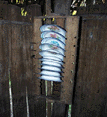 they go to the city or for special occasions.
they go to the city or for special occasions.
Most villages don't have electricity so you won't find many of
the modern conveniences that you find in the cities. People use
kerosene lamps which are tin cans with a little kerosene in the
bottom and a wick. Each family has a few plates and cups, but
there is little furniture in their houses. They go to bed early
and get up early because the sun rises and sets about the same
time all year long. During the day when they are not working they
often rest in hammocks. At night they use mosquito nets when they
are sleeping.
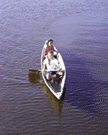 In
the rainforest there are no roads. The river is the highway. Everyone
living along the river has a canoe. Any time of day there are
people in canoes traveling up and down the river. The canoes are
made from hura, a type of tree found here. Some are made with
cedar, mahogany or rosewood. Most are carved with hand tools. In
the rainforest there are no roads. The river is the highway. Everyone
living along the river has a canoe. Any time of day there are
people in canoes traveling up and down the river. The canoes are
made from hura, a type of tree found here. Some are made with
cedar, mahogany or rosewood. Most are carved with hand tools.
The rhythm of daily life along the river is determined by the
flow of the river. "The river rises, the river falls and it is
the source of all life here."
|
|





